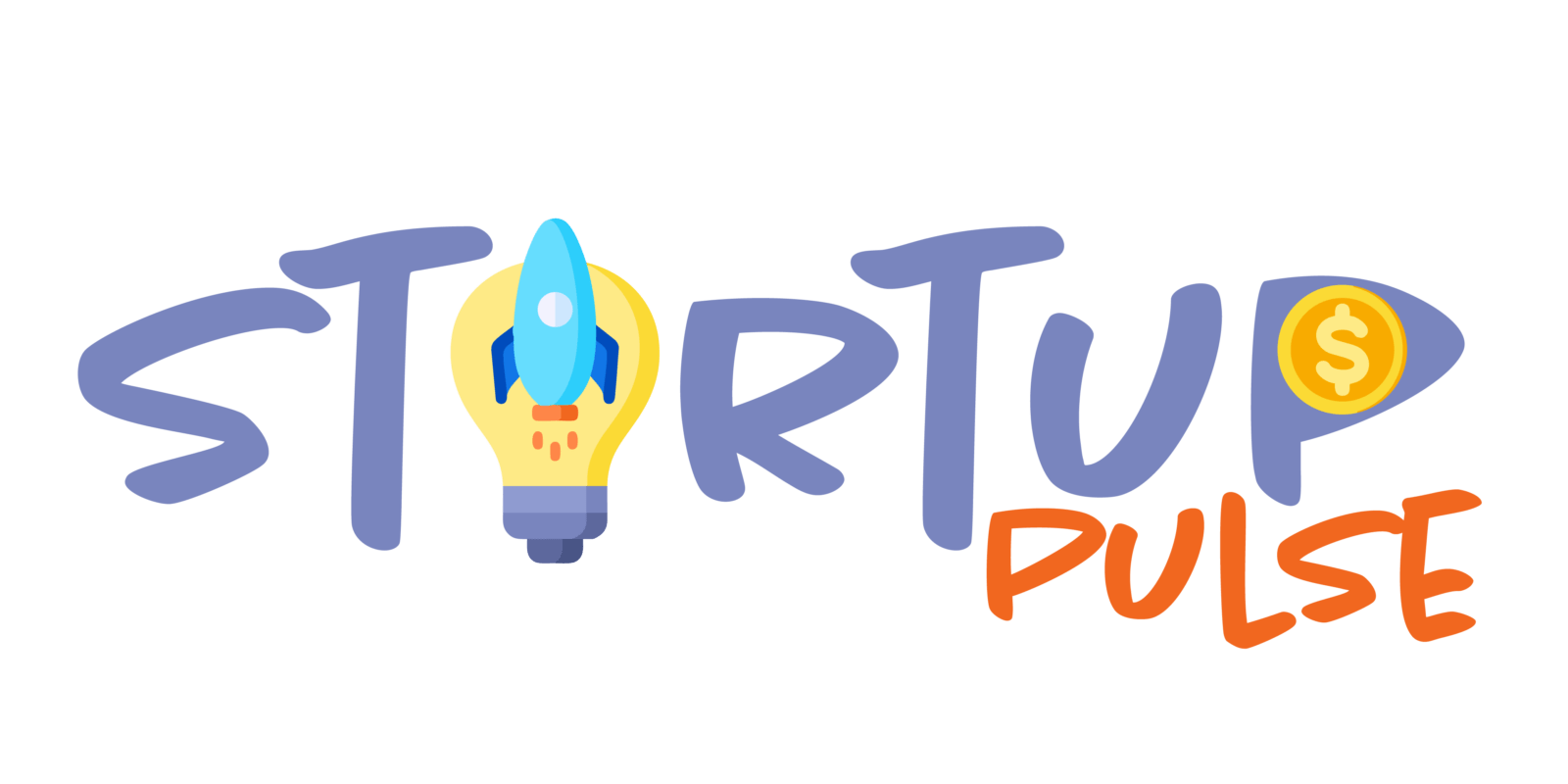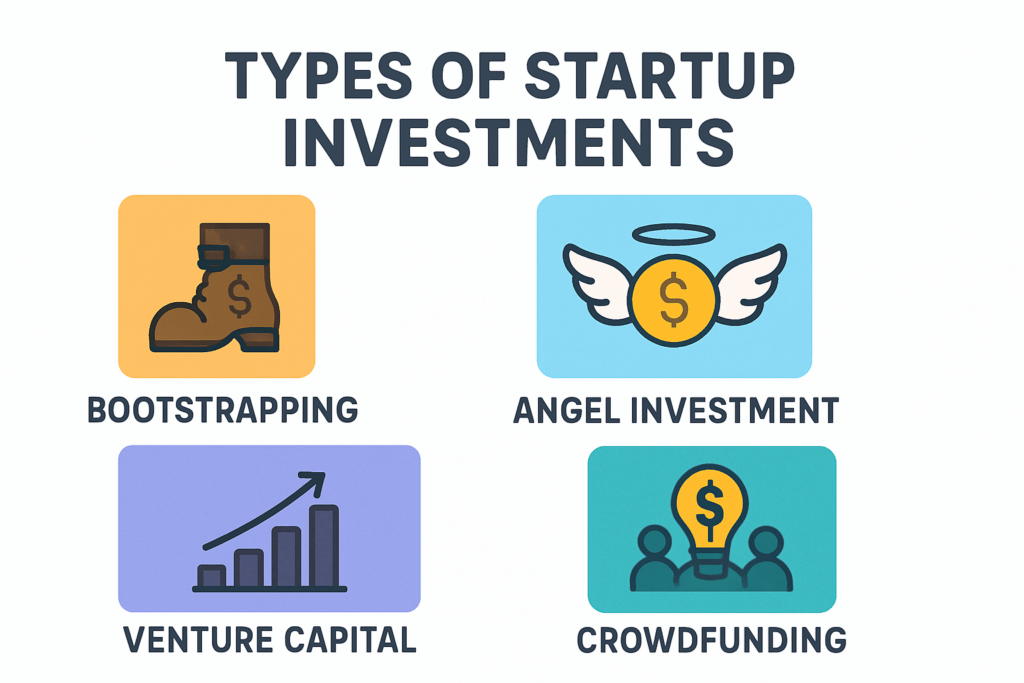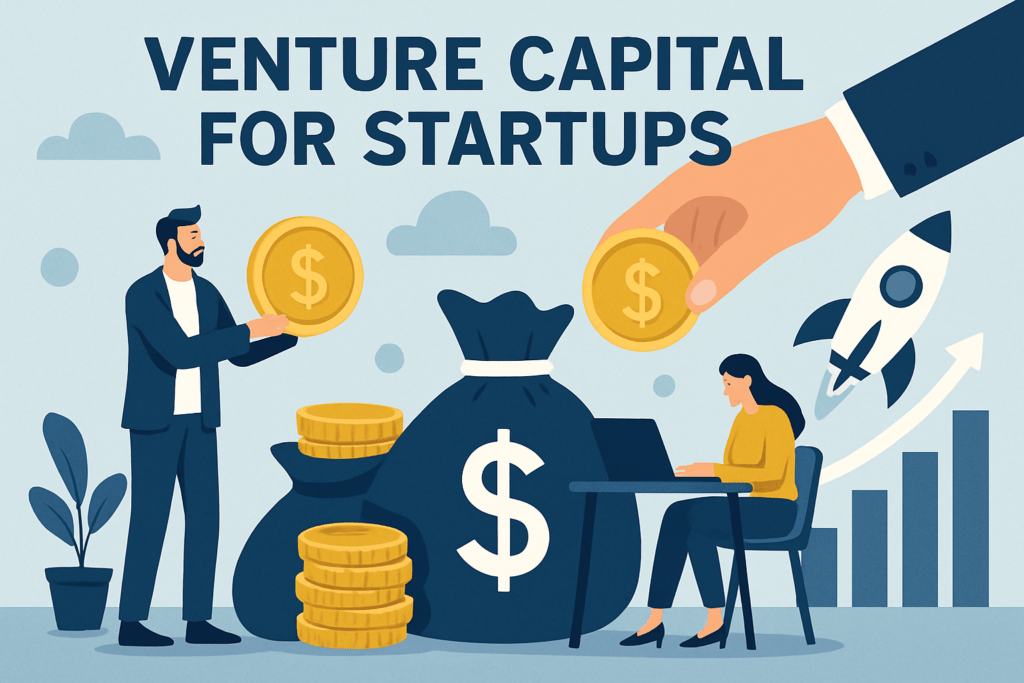Understanding the Different Types of Startup Investments: The 2025 Guide
- Being a founder or early-stage investor? Knowing your funding routes is essential.
- There’s more to startup investment than just “raising money.” Each type brings unique risks, rewards, and control quirks.
- Let’s cut through the jargon and take a smart, straightforward look at the types of startup investments you need to know.
Understanding the Different Types of Startup Investments: The 2025 Guide
Being a founder or early-stage investor? You live and die by your funding choices. It’s not just about getting cash in the door, it’s about how, from whom, and what they’ll want in return. Confused by the alphabet soup—SAFE, VC, Angel, Friends, and Family? Don’t be. Here’s the plain-English breakdown of your investment options, with zero fluff.
There are four main ways startups attract investment: leaning on their own bank account, pulling in cash from their network, opening up to the crowd, or chasing outside investors. Each comes with its own playbook, strings, and long-term punchlines. Sometimes, you’ll mix and match—using a family loan to get you through beta, then bringing on angels for your first proper hire, and maybe pulling in a VC when it’s time to blitzscale.
Understand this: every choice changes your runway, your power, and your exit. Some investments mean giving up a piece of your company. Some are debt that turns into ownership later. Others are just partnerships on paper. No path is one-size-fits-all. Knowing the types—before you start raising—means fewer regrets and more control when your startup actually takes off (or pivots).
So, ready for less hype, more real talk? Let’s size up the most important types of startup investments today.
Why Investment Models Matter
Let’s start with a blunt truth: not all money is created equal. The way you bring in capital can shape everything from how fast you grow to how much say you keep over your company. Maybe your startup is a low-lift side hustle that just needs some runway, or maybe you need rocket fuel for hyper-growth. That makes understanding your options—the actual investment models on the table—non-negotiable.
Bank loans. Sweat equity. Angel rounds. Venture capital. Each path sets a different tone and pace. Want to keep control close? Bootstrapping or a simple friends-and-family round might be your speed. Craving networks, mentorship, and scale? You’ll be looking at angels or institutional capital. But these come with terms, board seats, and the kind of pressure that can steal your weekends.
Bottom line: Knowing which model fits your needs now saves you stress (and probably equity) later. Take the time to match your funding partner and approach to the real needs of your vision—not just what’s trendy in your feed. Because once you take a certain kind of money, your company’s trajectory changes with it. Choose like it matters. Because it does.
Bootstrapping and Friends & Family: The Ground Floor
Every great startup story usually starts the same way: a founder with an idea, a fire in their gut, and not a lot of cash. That’s where bootstrapping and tapping your inner circle come in. Bootstrapping is a fancy way of saying you’re using your own savings (and maybe a few maxed-out credit cards) to fund the first steps. It’s gritty, and it’s how legends are born—think Mailchimp, Spanx, plenty of scrappy success stories.
For those who need a little more than what’s in their piggy bank, friends and family rounds are the next rung up. You ask people who believe in you—sometimes out of love more than business logic—to invest. Often it’s not a formal process. Sometimes it’s little more than a handshake and a promise.
Why bother with this approach? Two big reasons: (1) Control. You’re the boss, no outside investors calling the shots or loading you up with fine print. (2) Simplicity. No board meetings or complicated legal docs. Take the money, build the thing.
But make no mistake: this route has limits. The pool of cash is rarely huge. More importantly, you’re putting personal relationships on the line. If things go sideways, Thanksgiving dinner can get awkward. For some, that’s motivation; for others, it’s too much pressure.
Bottom line—bootstrapping and friends & family rounds get your wheels turning. Just know what you’re risking, and keep those receipts (your future self will thank you).
Crowdfunding: Many Backers, Momentum, and Storytelling
Crowdfunding is what happens when you trade a crowd’s excitement for capital, buzz, and maybe a few headaches. Platforms like Kickstarter and Indiegogo are ground zero for early-stage startups that don’t fit the traditional mold, letting you tap into regular people’s wallets (and hearts) instead of chasing big-money investors. You’re not just sourcing funds here—you’re building a tribe who cares, or at least cares enough to toss you $50 for a hoodie.
There are two main flavors: rewards-based crowdfunding (think: you promise early-bird gadgets, t-shirts, good karma) and equity crowdfunding, which is like a mini public offering where backers become shareholders. Rewards-based works great for product-driven startups with a devoted fan base or a killer story. Equity crowdfunding cuts in when you want to give up a piece of your company in exchange for serious capital—though the paperwork (and regulatory noise) jumps up a notch.
Why bother? Crowdfunding validates your idea in the wild, snags customers before you’re even a company, and gets your name out fast. Bonus: it’s non-dilutive (if you stick with rewards) and skips most of the suits and gatekeepers. But don’t kid yourself—it’s real work. Successful campaigns need sharp marketing, relentless energy, and an ironclad plan for delivering what you promise (on time).
Bottom line: Crowdfunding isn’t free money. It’s a public test. Pass, and you might raise both dollars and die-hard fans. Fail, and you learn harsh truths early, before bigger investors ask the tough questions. For a full tactical breakdown, start with the dos and don’ts of crowdfunding your startup.
What Happens After Winning Millions?
Winning a life-changing lottery jackpot is every player’s dream, but few are prepared for what comes next. The sudden influx of wealth can bring excitement, but also a wave of challenges.
Navigating Financial Complexity
Many winners find themselves overwhelmed by the new financial reality:
- Taxes and Legal Obligations
- A substantial portion of winnings often goes to taxes.
- Neglecting these obligations can lead to legal troubles.
- Investment vs. Spending
- Hiring financial advisors can help ensure long-term security.
- Some winners struggle with reckless spending that drains their fortune faster than expected.
Without proper planning, the dream of endless riches can quickly turn into a financial nightmare.
Lifestyle Transformations
For many winners, life changes dramatically and almost immediately:
- Indulging in Luxury
- Luxury homes, exotic cars, and extravagant vacations become a reality.
- However, these come with their own set of challenges.
- Social Dynamics
- Friends and distant relatives may emerge, hoping for a share of the winnings.
- This can create tension and difficult choices.
- Choosing Privacy Over Profligacy
- Some winners opt for low-profile lives to avoid attention and pressure.
Whether they embrace luxury or opt for discretion, adjusting to this new reality can be complex.
Using Wealth for Greater Good
Beyond personal wealth, some winners choose to make a significant social impact:
- Charitable Endeavors
- Many engage in generous charitable donations.
- Some fund scholarships or launch nonprofits.
- Community Investment
- Investing in community projects or revitalizing struggling towns is not uncommon.
The way winners handle their newfound riches determines not just their own future, but also the legacy they leave behind. While some create positive change, stories of financial downfall serve as cautionary tales for others navigating sudden wealth.
Venture Capital: Fuel for Fast Growth
Venture capital is where things get big—fast. Unlike your uncle’s check or an angel’s belief, venture capital (VC) firms show up when you need rocket fuel, not just pocket change. But it comes with strings, deal terms, and expectations. Let’s get tactical:
What Makes Venture Capital Different?
Venture capital usually means professional investors are betting on outsized returns. They take equity in exchange for big, risky bets on your growth potential. VCs expect venture scale—they’re not in it for small wins. They want you to go big or go home.
Venture Capital Types: Early vs. Late Stage
Not all VCs are built the same. Early-stage funds focus on Seed and Series A rounds—young startups, raw product, high uncertainty. They’ll tolerate more risk in exchange for a bigger potential slice of the pie. Late-stage VCs step in during Series B and C (and beyond), when you’ve got some revenue, traction, and data to back your story. They want to see you scale—fast.
Follow-On Investments
Unlike angels who might write a check and walk away, VCs often plan to double down. “Follow-on” means they invest more money in later rounds if you hit milestones. Done right, it’s fuel at every stage. But if you miss targets, don’t count on it—they’ll go cold, sharp.
How They Structure Deals
VC deals usually involve preferred shares (not the same as founder’s common stock). That means things like board seats, veto power, and liquidation preferences—protection if things go sideways. It’s a partnership, but also a negotiation. Expect detailed term sheets, due diligence, and scope for both upside—and control trade-offs.
Bottom line: With venture capital, you get acceleration, credibility, and access—but you’re also giving up autonomy. If you’re chasing hypergrowth and have the chops to match, this could be your track. Otherwise, think carefully before jumping in.
Convertible Notes and SAFEs: Simple, Flexible, But Sometimes Tricky
Convertible notes and SAFEs (Simple Agreements for Future Equity) are crowd favorites for early-stage startups and investors who want to move fast and avoid endless wrangling. Here’s the gist: Instead of handing over equity right away, you strike a deal now that converts into equity later—usually when you raise a bigger round.
Pros? They’re quick, cheap to set up, and don’t lock you into a full company valuation during those early, ambiguous days. That’s less headache and more runway for you. SAFEs in particular are designed to be “founder-friendly”—one doc, straightforward terms, minimal back-and-forth. Convertible notes, on the other hand, are technically short-term loans that turn into equity (often at a discount), sweetening the deal for your early supporters.
But don’t be lulled by their simplicity. The terms you set now—caps, discounts, interest rates—determine how much of your company you hand over down the road. Stack too many notes or SAFEs with different terms and you risk a dilution surprise when the conversions hit all at once in your next round. Bottom line: These tools buy you time and flexibility, but read the fine print and keep your future self in mind.
Strategic and Corporate Investors
If a big company comes knocking, it’s not just about the checkbook. Strategic and corporate investors—think Google Ventures, Intel Capital, or even less obvious players from your target industry—are after more than pure financial ROI. They may want early access to your tech, a way into your market, or even a peek at emerging threats and trends. The upside? Cash is just the beginning. Expect introductions, partnership opportunities, even manufacturing muscle or distribution firepower, all bundled in.
The flip side? Corporate priorities change. Strategic “fit” can get awkward if management shuffles or if your product suddenly looks less like a cool innovation and more like a future competitor. Sometimes these investors want special deals: board seats, rights of first refusal, veto power over new partnerships. It pays to get crystal-clear on what’s in the fine print and to have the “what if we break up?” conversation up front.
In short: treat corporate money as a powerful accelerant, but don’t tie yourself so tightly that you can’t pivot, raise again, or even exit on your own terms. Choose partners who see your startup as a win-win—not just a chess piece.
Comparing Your Equity Options
Let’s talk brass tacks: no two funding paths look the same. Here’s how the core equity options stack up, minus the fluff.
| Investment Type | Control | Speed | Capital Size | Exit Potential |
|---|---|---|---|---|
| Bootstrapping/Friends & Family | Maximum | Fast | Low-Medium | Total ownership = total reward (if you make it) |
| Crowdfunding | High | Fast-Medium | Low-Medium | Limited—hard to scale beyond initial buzz |
| Angel Investors | Medium-High | Fast-Medium | Low-Medium | Decent, especially if angels have good networks |
| Venture Capital | Medium-Low | Slow-Medium | High | High, but VC terms can sway your outcome |
| Convertible Notes/SAFEs | Medium | Fast | Low-Medium | Flexible, but tricky later if not managed well |
| Strategic/Corporate | Low-Medium | Slow-Medium | High | Big upside—if you mesh with the mothership |
Picking What Works
- Early stage: Bootstrapping, friends & family, or angels keep things lean and founder-friendly. You want speed and flexibility more than a huge check.
- Building momentum: Crowdfunding amplifies your story and gives you proof of market, but it’s not a giant windfall. Great for consumer products.
- Ready for scaling: VCs and corporate investors bring deep pockets—plus strings and expectations. Be honest about your appetite for rapid growth and shared control.
- Want speed with later clarity: If you need commitment now but aren’t ready to price your company, convertibles or SAFEs let you move quick—just watch the terms.
Bottom line: Your investment route should line up with your ambition, speed, and appetite for risk (and partners). Control isn’t free, but over-dilution is a sneaky killer. Take only the capital you really need, from people you actually want to work with.
Final Thoughts: Getting Strategic With Startup Funding
Let’s drop the fantasy of a one-size-fits-all investment path. The “right” type of funding for your startup is the one that fits your goals, timing, and personal risk tolerance—not what’s trending in headlines. Most founders end up combining different funding sources as their company grows (bootstrapping, then maybe angels, then a shot at VC, and so on). The key move? Stay awake at the wheel. Trends and terms in types of startup investments evolve fast, and what worked a year ago might be awkward (or even a liability) today. So, do your research, talk to peers, and—when in doubt—negotiate for flexibility. For deeper reading, bookmark this comprehensive guide on startup investment types. The smartest founders stay strategic, not just excited.
Takeaway
Fundraising isn’t just dollars in and equity out. It’s about aligning with backers who actually get your mission, not just your numbers. The smartest founders don’t chase the flashiest term sheets—they pick partners and investment models that leave their vision standing after the dust settles. Guard your cap table, weigh every option, and find the funding that grows with you—not over you.




